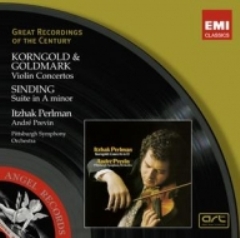Karl Goldmark – Violin Concerto No.1 in A Minor (Itzhak Perlman) [2008]
Karl Goldmark – Violin Concerto No.1 in A Minor (Itzhak Perlman) [2008]

1. Violin Concerto No. 1 in A Minor, Op. 28: I. Allegro moderato
2. Violin Concerto No. 1 in A Minor, Op. 28: II. Andante
3. Violin Concerto No. 1 in A Minor, Op. 28: III. Moderato - Allegretto
Itzhak Perlman – violin
Pittsburgh Symphony Orchestra
André Previn – conductor
The Violin Concerto No. 1 in A minor, Op. 28, by Karl Goldmark is his most frequently performed and recorded work. It is certain, however, that only the gripping virtuoso interest afforded by its rich and rewarding solo part has accorded the concerto a public status which now outstrips that of other formerly popular Goldmark's works, like his Rustic Wedding Symphony, and his operatic masterpiece The Queen of Sheba. The concerto was written in 1877 and received its first performance in Nuremberg (or Bremen, according to some sources) one year later.
A violinist by training, Goldmark knew well how to exploit the instrument's full potential, and in this work he created one of the nineteenth century masterworks of the violin repertory, deserving (on paper at least) to take its rightful place beside Romantic concertos by Mendelssohn, Tchaikovsky, Dvorák, Bruch, and others. As Benjamin Folkman writes, "the violin is very much a conciliator" in the opening movement (Allegro moderato) which begins with an abrupt-sounding march figure for the orchestra in angular, urgent dotted rhythms. This returns in more lyrical and reflective style with the first appearance of the soloist, to whom the luxuriant and expansive second subject group is also predominately entrusted. The development section is an ingenious fugato transformation of the first theme, now dispersed throughout the orchestra. The Andante in G major has a touching hymn-like quality, especially at the outset where the wind instruments provide an organ-like chordal accompaniment to the eloquent solo line. The devotional atmosphere is interrupted toward its close by a horn-call, and the violin immediately takes up the lively Allegretto theme of the finale. Stated a fourth lower, it re-establishes harmonic links with the idea given out at the very start of the concerto, but it has a completely different, more outgoing character, and its technical complexities (harmonics, double-stopping, and brilliant bow work) are of true virtuoso difficulty. A more songful second subject idea follows, but the cadenza (usually heard in the first movement) only appears after another fugato-like orchestral development. The concerto ends with a further affirmative reprise for orchestra of the powerful opening figure of the concerto, thus giving the whole convincing structural unity. ---Rovi
download: uploaded yandex anonfiles 4shared solidfiles mediafire mega gett filecloudio nornar
Last Updated (Monday, 13 January 2014 15:22)








